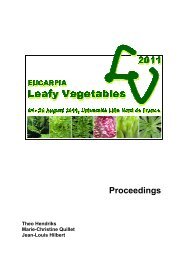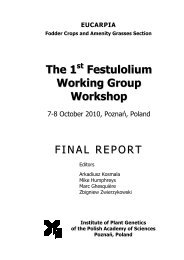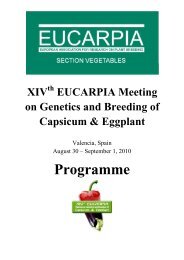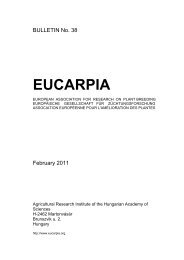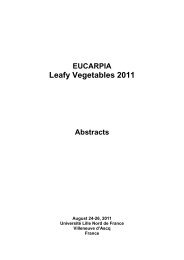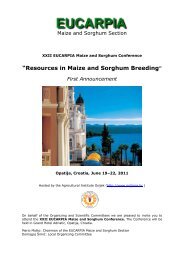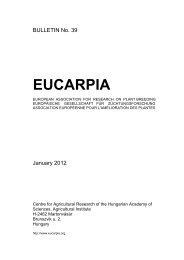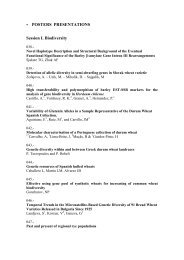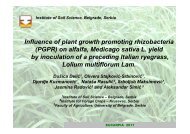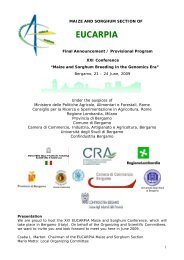Plant breeding for organic and sustainable, low-input agriculture
Plant breeding for organic and sustainable, low-input agriculture
Plant breeding for organic and sustainable, low-input agriculture
Create successful ePaper yourself
Turn your PDF publications into a flip-book with our unique Google optimized e-Paper software.
New F1 <strong>and</strong> open-pollinated spinach varieties <strong>for</strong> <strong>organic</strong> systems: a farmer, seed company,<br />
<strong>and</strong> non-profit model of participatory <strong>breeding</strong>.<br />
Micaela R. Colley, John P. Navazio,<br />
Organic Seed Alliance, Port Townsend, USA.<br />
Organic farming, a system which strives <strong>for</strong> reduced <strong>input</strong>s <strong>and</strong> optimized ecological health,<br />
requires plant varieties adapted to <strong>organic</strong> growing conditions. While <strong>organic</strong> producers<br />
primarily plant varieties bred by <strong>and</strong> <strong>for</strong> conventional systems, new models of participatory plant<br />
<strong>breeding</strong> (PPB) are emerging in which populations may be continually selected on-farm <strong>for</strong><br />
adaptation to diverse <strong>and</strong> evolving ecological conditions. Organic growers in the US serving<br />
fresh baby leaf <strong>and</strong> bunch markets desire varied spinach (Spinacia oleracea L.) types yet<br />
conventional breeders have focused on smooth leaf varieties <strong>for</strong> packaged baby spinach salad<br />
over the last decade. Organic growers <strong>and</strong> breeders would benefit from new, more erect, semisavoy<br />
spinach varieties <strong>for</strong> fresh market, selected <strong>and</strong> produced under <strong>organic</strong> conditions. F1 <strong>and</strong><br />
open-pollinated spinach varieties are being developed through a PPB model involving a<br />
commercial <strong>organic</strong> seed company (Seeds of Change, New Mexico), a non-profit research <strong>and</strong><br />
education organization (Organic Seed Alliance (OSA)), <strong>and</strong> nine <strong>organic</strong> farms in Washington,<br />
U.S.A.<br />
OSA staff, including a PhD plant breeder, developed initial <strong>breeding</strong> populations in western<br />
Washington, designed <strong>breeding</strong> methodologies, conducted statistical analysis, <strong>and</strong> trained<br />
farmers in selection, seed production, <strong>and</strong> trial layout procedures. Farmers identified desired<br />
traits, managed crops on-farm, <strong>and</strong> participated in on-farm selections <strong>and</strong> evaluations. All project<br />
partners were invited to participate in evaluations as an educational opportunity <strong>and</strong> to garner<br />
broad farmer-<strong>input</strong>. Nine open-pollinated <strong>breeding</strong> populations were mass selected over four<br />
generations <strong>for</strong> general adaptation to <strong>organic</strong> growing conditions along with desired phenotypic<br />
traits including savoyed texture, dark color, erectness, bolt resistance, <strong>and</strong> uni<strong>for</strong>mity. These<br />
genetically diverse populations were crossed to create twelve experimental F1s in 2005 <strong>and</strong> eight<br />
in 2006. These were not inbred lines, but phenotypically refined, genetically elastic populations<br />
which can be further selected. This approach differs from traditional hybrid <strong>breeding</strong> of crosspollinated<br />
species which aims <strong>for</strong> mono-genotypic populations through crossing of static,<br />
homozygous inbred lines. The resulting F1s were evaluated spring <strong>and</strong> fall on a single <strong>organic</strong><br />
farm in two-replicate observation plots in 2006 <strong>and</strong> replicated complete block design trials in<br />
2007 along with ten commercially available F1 <strong>and</strong> five open-pollinated varieties.<br />
Two of the experimental F1s, 509 <strong>and</strong> 515, identified as commercially promising semi-savoy<br />
varieties, will be further evaluated on larger-scale <strong>organic</strong> farms in varied regions in 2008. Of<br />
twenty seven varieties compared 515 <strong>and</strong> 509 were significantly more erect than twenty six <strong>and</strong><br />
twenty one varieties respectively (p=0.05). 515 <strong>and</strong> 509 were significantly more uni<strong>for</strong>m than<br />
seven <strong>and</strong> three of the commercial varieties respectively. Positive outcomes of this participatory<br />
model include new, adaptive <strong>organic</strong> varieties, new releases <strong>for</strong> an <strong>organic</strong> seed company, nonprofit<br />
support, improved farmer skills <strong>and</strong> education, <strong>and</strong> improved open-pollinated populations<br />
<strong>for</strong> future production <strong>and</strong> <strong>breeding</strong> activities.<br />
69




